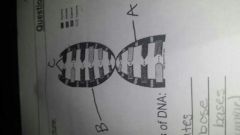![]()
![]()
![]()
Use LEFT and RIGHT arrow keys to navigate between flashcards;
Use UP and DOWN arrow keys to flip the card;
H to show hint;
A reads text to speech;
38 Cards in this Set
- Front
- Back
|
Cells are the ______ ______ of structure and __________ in all living things. |
Cells are the basic unit of structure and function in all living things. |
|
|
The Cell Theory states: |
1.All living things are composed of cells 2.Cells are the basic unit of structure and function in all living things 3.All cells are produced from other cells |
|
|
What is the difference between a unicellular and a multicellular organism? |
The difference is that an unicellular organism only has one cell, while a multicellular organism have more than one cell. |
|
|
How are cells organized in multicellular organisms? (List the levels of organization from smallest to largest) |
Cells, Tissues, Organ, Organ System |
|
|
What is the relationship between organelles and the cytoplasm? |
The relationship is that organelles float in cytoplasm and cytoplasm basically holds the organelles in place. |
|
|
Contains genetic material (DNA) |
Chromatin |
|
|
Produces energy |
Mitochondria |
|
|
Transports material from one part to another |
Endoplasmic Reticulum (ER) |
|
|
Produces proteins |
Ribosomes |
|
|
Recives and packages material from the ER |
Golgi Bodies |
|
|
Captures energy from the sun to make food |
Chloroplast |
|
|
Stores food, water and other material |
Vacuole |
|
|
Breaks down food and old cell parts |
Lysosomes |
|
|
Gel like material between the cell membrane and nucleus |
Cytoplasm |
|
|
Protects and supports the cell |
Cell Wall |
|
|
Controls what goes in and out of the cell |
Cell Membrane |
|
|
Directs all of the cell's activities |
Nucleus |
|
|
Surrounds the nucleus |
Nuclear Envelope |
|
|
Produces ribosomes |
Nucleolus |
|
|
Compare and contrast the cell membrane |
A cell Wall is only on plant cells and they give a cell it's shape. They both surround the cell. A cell membrane is in both plant and animal cells and it controls what goes in and out of the cell. |
|
|
Where is the genetic material found? |
The genetic material is found in chromatin. |
|
|
How are plant and animal cells alike and different? |
Alike:: Plant and animal cells both have a mitochondria, cell membrane, ribosome, nucleus and many other organelles. They are both cells. Different:: They are different because a plant cell uses sunlight for energy and food and has a cell wall and chloroplasts. |
|
|
The cell membrane is selectively permeable. What does this mean? |
That means the cell membrane doesn't let all substances pass through in and out of the cell. |
|
|
Compare and Contrast Passive and Active Transport |
Passive:: •Doesn't take energy •High to low concentration •Diffusion •Osmosis Active:: •Takes energy •Low to high concentration Both:: •Transport things |
|

Label the parts of DNA |
A- phosphates B- deoxyribose C- nitrogen bases |
|
|
The sides of a DNA ladder are made up of ___________ & ____________. |
The sides of a DNA ladder are made up of phosphates & deoxyribose. |
|
|
The sides of a DNA ladder are made up of 4 ____________ ____________. |
The sides of a DNA ladder are made up of 4 nitrogen bases. |
|
|
The four nitrogen bases are: |
• Thymine pairs with Adenine • Cytosine pairs with Guanine |
|
|
The shape of DNA can be described as a ___________ staircase. |
The shape of DNA can be described as a twisted staircase. |
|
|
Describe the process of DNA replication. |
The process of DNA replication is the DNA unwinds and the new strands replicate and those strands unwind and replicate to make new strands. That process repeats over and over again. |
|
|
What is the purpose of DNA replication? |
The purpose of DNA replication is each daughter cell will have all the genetic information it needs to carry out its activities. |
|
|
Briefly explain what happens in each stage of the cell cycle: • Interphase:: • Mitosis:: • Cytokinesis:: |
• Interphase:: Growth, DNA replication occurs • Mitosis:: The nucleus separates • Cytokinesis:: Cytoplasm divides to create two new daughter cells. |
|
|
Place the following phases of mitosis in the correct order:: Anaphase, Metaphase, Telophase, & Prophase |
Prophase --> Metaphase --> Anaphase --> Telophase |
|
|
Uses food to produce energy |
Respiration |
|
|
Raw materials= Glucose & Oxygen |
Respiration |
|
|
Requires energy from the sun |
Photosynthesis |
|
|
Occurs in the cytoplasm & mitochondria |
Respiration |
|
|
Does NOT occur in animal cells |
photosynthesis |

